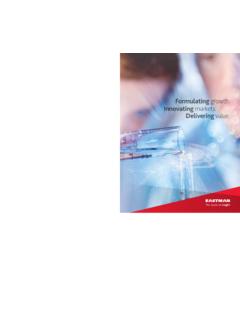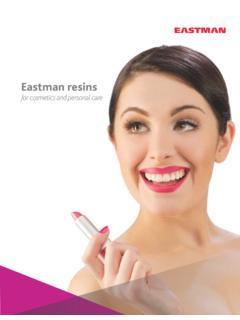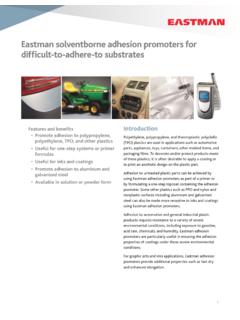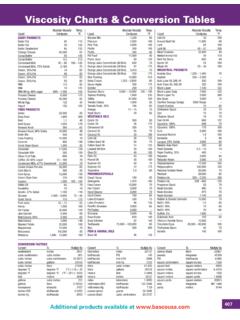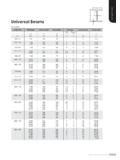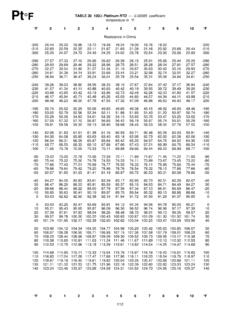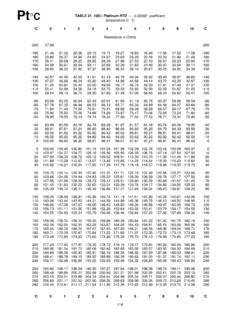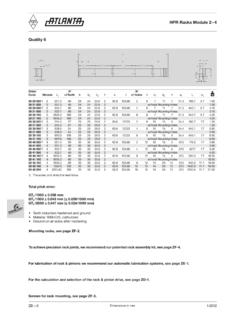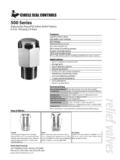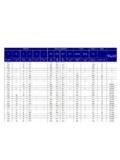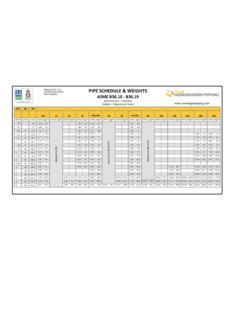Transcription of Eastar copolyester 6763 - eastman.com
1 Eastar copolyester 6763technical informationContentsEastar copolyester 6763 1 Properties 1 Optical 1 Thermal and rheological 1 Burning characteristics 1 Chemical resistance 5 Barrier properties 5 Weatherability 5 Color 5 Quality manufacturing 5 Rheological properties of Eastar copolyester 6763 6 Table 1 Physical properties of film extruded in Eastman s laboratories from Eastar copolyester 6763 2 Table 2 Thermal properties of Eastar copolyester 6763 4 Table 3 Electrical properties of Eastar copolyester 6763 5 Table 4 Rheological properties of Eastar copolyester 6763 using a capillary rheometer and constant shear rate method 8 Figure 1 Viscosity vs temperature
2 6 Figure 2 Viscosity vs shear rate 6 Figure 3 Viscosity vs shear stress 7 Figure 4 Shear stress vs shear rate 71 Eastar copolyester 6763 Eastar copolyester 6763 is useful in a variety of processes and applications because of its clarity, toughness, and good melt strength at processing temperatures These include: Film and sheet extrusion Applications Sheet for protective covers and displays Thermoformed containers for rigid medical packaging, refrigerated/frozen foods, candies, and sundries Features Gloss, transparency, toughness, fast-forming cycles, ease of forming, reusable scrap, radio frequency sealable, and resistance to stress-whitening Extrusion blow molding Applications Bottles for packaging shampoos, soaps, detergents, and oils Features Clarity, barrier properties, chemical resistance, toughness, and processability Shape and tubing extrusion Applications Packaging, protective sleeves, and various profiles Features Clarity, toughness.
3 And cost savings Eastar copolyester 6763 is a clear amorphous polymer with a glass transition temperature (Tg) of approximately 80 C (176 F) as determined by Differential Scanning Calorimetry It is based on poly(ethylene terephthalate) and has a number-average molecular weight (Mn) of about 26,000 copolyester 6763 pellets have a poured bulk density (by ASTM D1895) of about 721 kg/m3 (45 lb/ft3) and a vibrated bulk density of about 801 kg/m3 (50 lb/ft3) As is the case with all thermoplastic polyesters, 6763 is subject to hydrolysis when it is in the molten state during processing This hydrolysis results in a decrease in molecular weight that is reflected by a lowering of physical properties, especially toughness To prevent a harmful degree of hydrolysis during processing, 6763 should be thoroughly dried Drying the material in a dehumidifying dryer at a temperature of 65 C (~150 F) for 6 hours is normally sufficient to reduce the moisture content to less than 0 04% and to prevent significant hydrolysis in processing equipment operating at 195 to 275 C (380 to 525 F)
4 PropertiesOpticalItems produced from Eastar copolyester 6763 by blow molding or extrusion can have good transparency, low haze, and high gloss Optical properties of 250-micron (10-mil) film extruded from 6763 are given in Table 1 along with other film properties Thermal and rheologicalSince Eastar copolyester 6763 is amorphous, its thermal properties are essentially determined by its glass transition temperature of approximately 80 C (176 F) This copolyester has deflection temperatures of 64 C (147 F) at a fiber stress of 1 82 MPa (264 psi) and 70 C (158 F) at 0 455 MPa (66 psi) Deflec tion temperatures and other thermal properties are given in Table 2 Drying temperatures must be no higher than 65 C (~150 F) to prevent pellets from sticking together in the dryer At relatively low processing temperatures of 195 to 220 C (380 to 425 F), Eastar copolyester 6763 has a desirable combination of melt viscosity/melt strength, enabling the material to be used in parison extrusion for blow molding At temperatures encountered in injection molding (250 to 270 C [480 to 520 F])
5 , the viscosity of 6763 decreases with increase in temperature and shear rate The effects that temperature, shear rate, and shear stress have on the viscosity of 6763 are shown in Figures 1, 2, and 3 Shear stress versus shear rate is given in Figure 4 The rheological properties of 6763 are summarized in Table 4 Burning characteristicsEastar copolyester 6763 has been tested by Underwriter s Laboratories (Test Method UL 94) and classified as follows:ThicknessRating1 14 mm (0 0449 in )94HB2 Table 1 Physical properties of film extruded in Eastman s laboratories from Eastar copolyester 6763(continued on next page)Property,a unitsTypicalvalue Test methodASTMISOI nherent viscosity0 70 b bThickness of film testedMicrons250D374 Mils10 Density, g/cm31 27D15051183, method DHaze, %0 8D1003 Gloss @ 45 108D2457 Transparency, %85D1746 Transmittance, %D1003 modifiedRegular (specular)Total89 91 Water vapor transmission ratecg/m2 24h6F372 g/100 in 2 24h0 4 Gas permeability cm3 mm/m2 24h atm (cm3 mil/100 in 2 24h atm) CO249 (125)D1434O210 (25)D3985 Elmendorf tear resistance, N (gf) D19226383/2M D 13 7 (1,400)T D 16 7 (1,700)PPT tear resistance, N (lbf) M D 93 (21)D2582 T D 93 (21)
6 Tear propagation resistance Split-tear method @ 254 mm/min (10 in /min) M D , N (lbf)9 1 (2 1)D1938 N/mm (lbf/in )36 (205)T D , N (lbf)9 1 (2 1) N/mm (lbf/in )36 (205)3 Table 1 (Continued)aUnless noted otherwise, all tests were run @ 23 C (73 F) and 50% relative viscosity was determined using test method conducted @ 38 C (100 F) and 100% relative variation is inherent in all plastics testing, and the preceding data are considered to be representative of average properties for 250-micron (10-mil) film Eastman makes no representation that the material in any particular shipment will conform exactly to the values given Property,a unitsTypicalvalue Test methodASTMISOTear resistance, trouser @ 200 mm/min speed, N/mm (lbf/in ) 6383/1M D 36 (205)T D 36 (205)Tensile strength @ yield, MPa (psi)M D 52 (7,500)T D 52 (7,500)Tensile strength @ break, MPa (psi) M D 59 (8,600)T D 55 (8,000)D882527-3/2/50 Elongation @ yield, % M D 4T D 4 Elongation @ break, % M D 400T D 400 Tensile modulus, MPa (105 psi)527-3/2/25,254-mm gauge lengthM D 1,900 (2 8)D882T D 1,900 (2 8)Dart impact, 12 7-mm (a-in ) dia head, 127-mm (5-in ) dia clamp, 660-mm (26-in ) drop, gD1709 AMethod Amodified7765/AMethod Amodified@ 23 C (73 F)400 18 C (0 F)
7 5004 Table 2 Thermal properties of Eastar copolyester 6763aUnless noted otherwise, all tests were run @ 23 C (73 F) and 50% relative transition temperature and specific heat were determined by reported here are typical of average lots Eastman makes no representation that the material in any particular shipment will conform exactly to the values given Property,a unitsTypicalvalueTest methodASTMISOD eflection temperature @ 1 82 MPa (264 psi) fiber stress, C64D64875 F147 @ 0 455 MPa (66 psi) fiber stress, C70 F158 Vicat softening point, C85D1525306 F185 Thermal conductivity, W/m K0 21C177 Btu in /h ft2 F1 5 Glass transition temperature, C80 b b F176 Specific heat, kJ/kg K (Btu/lb F) @ 60 C (140 F)1 30 (0 31) b b 100 C (212 F)1 76 (0 42) 150 C (302 F)1 88 (0 45) 200 C (392 F)1 97 (0 47) 250 C (482 F)2 05 (0 49)Coefficient of linear thermal expansion,mm/mm C (230 to 140 C) 5 1 3 10 5D696 Flammability (3 2-mm [1 8-in ] thick specimen)cm/min,2 5D635 in /min,1UL flammability classification1 14 mm (0 0449 in )
8 94 HBUL 94 Oxygen index, %24D2863 Melt density @ 200 C, g/cm31 19D1238 250 C, g/cm30 985 Table 3 Electrical properties of Eastar copolyester 6763aUnless noted otherwise, all tests were run @ 23 C (73 F) and 50% relative resistanceUnstressed tensile bars molded of Eastar copolyester 6763 exhibit good resistance to dilute aqueous solutions of mineral acids, bases, salts, and soaps, and to aliphatic hydrocarbons, alcohols, and a variety of oils Halogenated hydrocarbons, short chain length ketones, and aromatic hydrocarbons dissolve or swell the plastic The chemical resistance of Eastar copolyester 6763 is the subject of a separate Eastman publication, TR-145, that is available on request Barrier propertiesWater-vapor transmission rate and gas permeability measured on 250-micron (10-mil)
9 Film are given in Table 1 WeatherabilityEastar copolyester 6763 does not contain a UV absorber, and it is not suggested for use in applications involving continuous long-term outdoor exposure ColorEastar copolyester 6763 may be colored using color concentrates, dry colors, or liquid colorants To provide material compatibility, Eastman offers color concentrates compounded in an Eastar copolyester 6763 base Most color concentrates are custom-made, but a few standard concentrates are available from stock The mixing ratio for 6763 and color concentrate is usually 20:1 Color concentrates should be dried in a manner similar to that suggested for 6763 to minimize hydrolytic degradation during processing Quality manufacturingEastar copolyester 6763 is manufactured under a quality system that is registered by BSI, Certificate No FM 14068, conforming to the requirements of ISO 9001.
10 2008 Property,a unitsTypicalvalueTest methodDielectric constantASTM D150 @ 1 kHz2 6 1 MHz2 4 Dissipation factor @ 1 kHz0 005 1 MHz0 02 Arc resistance, s158 ASTM D495 Volume resistivity, ohm cm1015 ASTM D257 Surface resistivity, ohm/square1016 ASTM D257 Dielectric strength, short time @ 500 V/sec rate-of-rise, 3 2-mm (l-in ) thick test specimen, kV/mm (V/mil)16 (410)ASTM D149 Properties reported here are typical of average lots Eastman makes no representation that the material in any particular shipment will conform exactly to the values given 6 Rheological properties of Eastar copolyester 6763200220230240250270200210220230240270 100101100101806040208060402086428642 Shear rateSec in. tube90 included angle entryL/D ratio 20 Viscosity, poise 103250260Te mperature, C210260 Figure 1 Viscosity vs.


